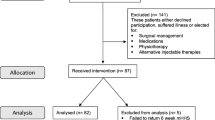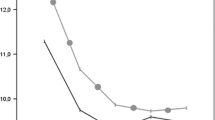Abstract
Aim
To evaluate, in daily clinical practice, the efficacy and tolerability of a single intra-articular injection of non-animal-stabilized hyaluronic acid (NASHA) in patients treated for symptomatic hip OA (HOA).
Methods
Standardized follow-up (FU). Patients: forty patients suffering from HOA treated by a single intra-articular injection of NASHA in the painful hip under fluoroscopy. Evaluation: patient global assessment (PGA) and walking pain (WP) on a 100 mm visual analogue scale, WOMAC index, Lequesne index at each visit. Statistics: last observation carried forward. Treatment efficacy was assessed using OMERACT-OARSI response criteria, minimal clinically important improvement (MCII), patient acceptable symptom state (PASS) obtained from PGA, WOMAC and WP. Predictive factors of efficacy were also studied.
Results
Efficacy evaluation: 34 patients were assessable (mean FU 159 days). All clinical variables (WP, PGA, WOMAC, Lequesne index) decreased significantly between baseline and last evaluation. Twenty-two patients (71%) were classified OMERACT-OARSI responders, 25 subjects (75.8%) were classified PASS+, and 19 (61.3%) fulfilled criteria for MCII. Out of clinical and radiological variables only Lequesne index (p = 0.04) and WOMAC (p = 0.04) at baseline were found to be predictive of treatment efficacy. Safety evaluation: the treatment was well tolerated. There were no severe adverse events related to the treatment or to the procedure. However 15 of the 28 assessable patients experienced transient increase of pain in the target hip during the first week after injection.
Conclusion
Viscosupplementation of the hip with NASHA is easily feasible in daily clinical practice, safe and well tolerated despite a frequent increase of pain the days following injection. Prospective controlled trials are needed to confirm these data and to evaluate both safety and efficacy of a second course of treatment.


Similar content being viewed by others
References
Felson DT (1988) Epidemiology of knee and hip osteoarthritis. Epidemiol Rev 10:1–1800
Oliveria SA, Felson DT, Reed JI, Cirillo PA, Walker AM (1995) Incidence of symptomatic hand, hip and knee osteoarthritis among patients in health maintenance organizations. Arthritis Rheum 38:1134–1141C. doi:10.1002/art.1780380817
Wilson MG, Michet CJ, Ilstrup DM, Melton LJ (1990) Idiopathic symptomatic osteoarthritis of the hip and knee. A population-based incidence study. Mayo Clin Proc 65:1214–1221
Hochberg MC, Altman RD, Brandt KD, Clark BM, Dieppe PA, Griffin et al (1995) Guidelines for the medical management of osteoarthritis. Part I. Osteoarthritis of the hip. Arthritis Rheum 38(11):1535–1540. doi:10.1002/art.1780381103
American College of Rheumatology subcommittee on osteoarthritis guidelines (2000) Recommendations for the medical management of osteoarthritis of the hip and the knee. 2000 update. Arthritis Rheum 43:1905–1915 doi: 10.1002/1529-0131(200009)43:9<1905::AID-ANR1>3.0.CO;2-P
Jordan KM, Arden NK, Doherty M, Bannwarth B, Biljsma JWJ, Dieppe P et al (2003) EULAR recommendations 2003: an evidence based approach to the management of knee osteoarthritis: report of a task force of the standing committee for international clinical studies including therapeutic trials (ESCISIT). Ann Rheum Dis 62:1145–1155. doi:10.1136/ard.2003.011742
Pendleton A, Arden N, Dougados MM, Bannwarth B, Biljsma JWJ et al (2000) EULAR recommendations for the management of knee osteoarthritis: report of a task force of the standing committee for international clinical studies including therapeutic trials (ECSISIT). Ann Rheum Dis 59:936–944. doi:10.1136/ard.59.12.936
Conrozier T, Jousseaume CA, Mathieu P, Tron AM, Caton J, Bejui J et al (1998) Quantitative measurement of joint space narrowing progression in hip osteoathritis: a longitudinal retrospective study of patients treated by total hip replacement. Br J Rheumatol 17:961–968. doi:10.1093/rheumatology/37.9.961
Moore RA, Derry S, McQuay HJ (2007) Cyclo-oxygenase-2 selective inhibitors and nonsteroidal anti-inflammatory drugs: balancing gastrointestinal and cardiovascular risk. BMC Musculoskelet Disord 3:73. doi:10.1186/1471-2474-8-73
Pelletier JP, Martel-Pelletier J (1993) The pathophysiology of osteoarthritis and the implication of the use of hyaluronan and hylan as therapeutic agents in viscosupplementation. J Rheumatol 20(suppl 39):19–23
Dickson DJ, Hosie G (2001) A double blind, placebo-controlled comparison of hylan GF 20 against diclofenac in knee osteoarthritis. J Clin Res 4:41–52
Qvistgaard E, Christensen R, Torp-Pedersen S, Bliddal H (2006) Intra-articular treatment of hip osteoarthritis: a randomized trial of hyaluronic acid, corticosteroid, and isotonic saline. Osteoarthritis Cartilage 14:163–170. doi:10.1016/j.joca.2005.09.007
Conrozier T, Bertin P, Mathieu P et al (2003) Intra-articular injections of hylan G-F 20 in patients with symptomatic hip osteoarthritis: an open-label, multicentre, pilot study. Clin Exp Rheumatol 21:605–610
Bragantini A, Molinari F (1994) A pilot clinical evaluation of the treatment of hip osteoarthritis with hyaluronic acid. Curr Ther Res 55:319–330. doi:10.1016/S0011-393X(05)80175-4
Migliore AA, Martin LS, Alimonti A, Valente C, Tormenta S (2003) Efficacy and safety of viscosupplementation by ultra-sound guided intra-articular injection in osteoarthritis of the hip. Osteoarthritis Cartilage 11:305–306. doi:10.1016/S1063-4584(03)00008-6
Berg P, Olsson U (2004) Intra-articular injection of non animal stabilised hyaluronic acid for osteoarthritis of the hip: a pilot study. Clin Exp Rheumatol 22:300–306
Conrozier T, Vignon E (2005) Is there evidence to support the inclusion of viscosupplementation in the treatment paradigm for patients with hip osteoarthritis? Clin Exp Rheumatol 23(5):711–716
Altman RD, Akermark C, Beaulieu AD, Schnitzer T (2004) Durolane international study group efficacy and safety of a single intra-articular injection of non-animal stabilized hyaluronic acid (NASHA) in patients with osteoarthritis of the knee. Osteoarthritis Cartilage 12:642–649. doi:10.1016/j.joca.2004.04.010
Altman R, Alarcon D (1991) Appelrouth D and the American College of Rheumatology subcommittee on criteria for osteoarthritis. The American College of Rheumatology criteria for the classification and reporting of osteoarthritis of the hip. Arthritis Rheum 34(5):505–511. doi:10.1002/art.1780340502
Kellgren JH, Lawrence JS (1957) Radiological assessment of osteoarthrosis. Ann Rheum Dis 16:494–501
Lequesne MG, Laredo JD (1998) The faux profil (oblique view) of the hip in the standing position: contribution to the evaluation of osteoarthritis of the adult hip. Ann Rheum Dis 57:676–681
Lequesne MG (1997) The algofunctional indices for hip and knee osteoarthritis. J Rheumatol 24:779–781
Bellamy N, Buchanan WW, Goldsmith CH, Campbell J, Stitt WJ (1995) Validation of WOMAC. A health status instrument for measuring clinically important patient outcomes to rheumatic drug therapy in patients with osteoarthritis of the hip or knee. J Rheumatol 15:1833–1840
Pham T, Van Der Heijde D, Altman RD, Anderson JJ, Bellamy N, Hochberg M et al (2004) OMERACT-OARSI Initiative: Osteoarthritis Research Society International set of responder criteria for osteoarthritis clinical trials revisited. Osteoarthritis Cartilage 12:389–399
Tubach F, Ravaud P, Baron G, Falissard B, Logeart I, Bellamy N et al (2005) Evaluation of clinically relevant states in patient reported outcomes in knee and hip osteoarthritis: the patient acceptable symptom state. Ann Rheum Dis 64:34–37
Tubach F, Ravaud P, Baron G, Falissard B, Logeart I, Bellamy N et al (2005) Evaluation of clinically relevant changes in patient reported outcomes in knee and hip osteoarthritis: the minimal clinically important improvement. Ann Rheum Dis 64:29–33
Altman R, Gold GE (2007) Atlas of individual radiographic features in osteoarthritis revised. Osteoarthritis Cart 15(suppl):A1–A56
Ledingham J, Dawson S, Preston B, Milligan G, Doherty M (1992) Radiographic patterns and associations of osteoarthritis of the hip. Ann Rheum Dis 51:1111–1116
Conrozier T, Bertin B, Bailleul F, Mathieu P, Charlot J, Vignon E et al (2006) Clinical response to intra-articular injections of hylan g-f 20 in symptomatic hip osteoarthritis: the OMERACT-OARSI criteria applied to the results of a pilot study. Joint Bone Spine 73:705–709. doi:10.1016/j.jbspin.2006.02.008
Lussier A, Cividino AA, Mc Farlane C, Olszynski WP, Potashner WJ, Medicis R (1996) Viscosupplementation with Hylan for the treatment of osteoarthritis: findings from clinical practice in Canada. J Rheumatol 23:1579–1585
Conrozier T, Mathieu P, Schott AM et al (2003) Factors predicting long term efficacy of hylan GF-20 viscosupplementation in knee osteoarthritis? Joint Bone Spine 70:128–133. doi:10.1016/S1297-319X(03)00005-8
Toh EM, Prasad PS, Teanby D (2002) Correlating the efficacy of knee viscosupplementation with osteoarthritic changes on roentgenological examination. Knee 9:321–330. doi:10.1016/S0968-0160(02)00040-6
Acknowledgments
The authors would like to thank Richard Gradin and Martine Guirlinger from Q-Med laboratories for supplying the NASHA samples, Eric Noel and Monique Bonjean for their clinical contribution and Marie Conrozier, Sylvie Conrozier and Christelle Szatanek for their assistance in the data collection.
Author information
Authors and Affiliations
Corresponding author
Rights and permissions
About this article
Cite this article
Conrozier, T., Couris, C.M., Mathieu, P. et al. Safety, efficacy and predictive factors of efficacy of a single intra-articular injection of non-animal-stabilized-hyaluronic-acid in the hip joint: results of a standardized follow-up of patients treated for hip osteoarthritis in daily practice. Arch Orthop Trauma Surg 129, 843–848 (2009). https://doi.org/10.1007/s00402-008-0778-4
Received:
Published:
Issue Date:
DOI: https://doi.org/10.1007/s00402-008-0778-4




